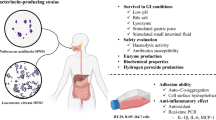Abstract
An indigenous food mixture was developed by mixing barley flour (raw and germinated), whey powder and tomato pulp in the ratio of 2:1:1:1 (w/w). The developed food (100 g) was mixed with water (500 ml) and autoclaved at 1.5 kg/cm2 for 15 min. It was then cooled and inoculated with Lactobacillus acidophilus curd (5%) and incubated at 37°C for 12 h containing 106 cfu/ml broth. Fermented food mixture formulated from germinated barley flour maintained adequate cell viability (8.88 cfu/ml) as compared to non-germinated food mixture. To study the therapeutic effect of the food mixture, diarrhoea was induced in mice using 0.5 ml of aqueous suspension orally with the help of sterilized syringe to each of the overnight fasted mice and the mice were examined till onset of diarrhoea. The aqueous suspension was prepared by using 10 ml of six h old culture of E. coli cells (5 × 1011 cfu/ml) and 6 ml alkaline solution (powdered chalk (40%), colloidal kaolin (43%) and magnesium trisilicate (17%) and both were mixed in 10:6 (v/v) proportions. After induction of diarrhoea, the mice were divided in two groups, control and experimental. The control group was fed on unfermented food mixture whereas experimental group was fed on fermented food mixture. Faecal ash, nitrogen, moisture and coliform count increased while faecal lactobacilli count decreased in mice having diarrhoea. In the experimental group, which was fed on fermented food mixture, normal values were reached within 7 days of feeding but no such changes were observed in control group which was fed on unfermented food mixture. Liver and kidney showed lesions due to E. coli infection were significantly alleviated on feeding of probiotic food mixture.



Similar content being viewed by others
References
Agte VV, Gokhale MK, Chiplonkar SA (1997) Effect of natural fermentation on in vitro zinc bioavailability in cereal legume mixtures. Int J Food Sci Technol 32:29–32
Amerine MA, Berg HW, Cruess WV (1967) The technology of wine making. AVI, Westport, p 692
Antony U, Sripriya G, Chandra TS (1996) Effect of fermentation on the primary nutrients in finger millet (Eleusine coracana). J Food Sci 44:2616–2618
AOAC (1995) Official methods of analysis of the association of official agricultural chemists. Association of Analytical Chemists, Washington DC, pp 125–129
Blomberg L, Henriksson A, Conway PL (1993) Inhibition of Escherichia coli K-88 to piglet ileal mucus by Lactobacillus spp. App Environ Microbiol 59:34–39
Chahal S (1999) Development of probiotic fermented indigenous food blends: Their nutrient composition and their therapeutic use. Ph.D. thesis. CCS Haryana Agricultural University Hisar India
Chaudhary P (1998) Probiotic fermentation of blends containing locally available food stuffs: Their nutrient composition and role in control of diarrhea. Ph.D. thesis. Haryana Agricultural University Hisar India.
Fuller R (1992) History and development of probiotics. In: Fuller R (ed) Probiotics. London, Chapman and Hall
Gill HS (2006) Probiotics to enhance anti effective defenses in gastrointestinal tract. Best Pract Res Clin Gastroenterol 17:833–848
Gorbach SL (1996) Efficacy of Lactobacilli in treatment of acute diarrhea. Nutr Today 31:195–235
Henryk S, Agnieszka C, Magdalena S, Jerzy P (2006) Colonization of the gastrointestinal tract by probiotic L. rhamnosus strain in acute diarrhoea in children. Diges Liver Dis 38:38–40
Lindsey WL, Norwell MA (1969) A new DPTA—TEA soil test for zinc and iron. Agro Abstr 61:61–84
Luna LG (1968) Manual of histological staining methods of armed forces institute of pathology. McGraw Hill Book Company, New York
Mishra V, Prasad DN (2001) Prebiotic foods and their applications in health management. Ind Food Ind 20:59–61
Nomoto K (2005) Review: prevention of Infections by probiotics. J Biosci Bioeng 100:583–592
Panse YG, Sukhatme PV (1961) Statistical methods of agricultural coworkers. New Delhi, Indian Council of Agricultural Research
Peter HK (1996) Probiotic control of diarrhoeal disease. Asia Pac J Clin Nutr 5:39–43
Rani B, Khetarpaul N (1999) Probiotic fermented food mixture: possible application in clinical and anti-diarrhoea usage. Nutr Health 12:97–105
Reid G (2005) The importance of guidelines in the development and application of probiotics. Curr Pharma Des 11:11–16
Reid G, Jass J, Sebulsky MT, McCormick JK (2003) Potential uses of probiotics in clinical practice. Clin Microbiol Rev 16:658–672
Sindhu SC, Khetarpaul N (2001) Probiotics: nutritional and health benefits. Life Sci Reporter 3:1–10
Santosa S, Farnworth E, Jones P (2006) Probiotics and their potential health claims. Nutr Rev 64:265–274
Sharma G, Ghosh BC (2006) Probiotic dairy foods and probiotics for health benefits. Ind Food Ind 25:68–73
Sripriya G, Usha A, Chandra TC (1997) Changes in carbohydrates, free amino acid, organic acid, phytate and HCl-extractability of minerals during germination and fermentation of finger millet (Eleusine coracana). Food Chem 58:345–350
Acknowledgements
Senior author is grateful to the Department of Biotechnology, New Delhi, India for providing financial assistance for carrying out a research project. We also thankful to Dr. Minakshi, Department of Animal Biotechnology and Dr. Rajender Gupta, Department of Veterinary Pathology for assisting with this experiment.
Author information
Authors and Affiliations
Corresponding author
Rights and permissions
About this article
Cite this article
Jood, S., Khetarpaul, N. & Goyal, R. Efficacy of barley based probiotic food mixture in treatment of pathogenic E.coli induced diarrhoea in mice. J Food Sci Technol 49, 200–206 (2012). https://doi.org/10.1007/s13197-011-0270-y
Revised:
Accepted:
Published:
Issue Date:
DOI: https://doi.org/10.1007/s13197-011-0270-y




